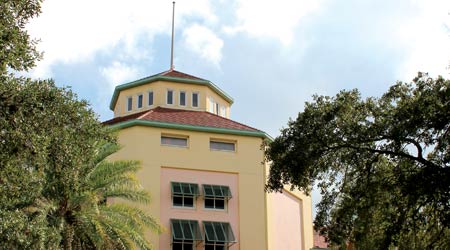view all Case Studies
Ice-based Energy Storage Cuts Headquarters' Daytime Energy Demand in Half

The Alachua County Library Headquarters, built in 1992, is the central administrative location for the Alachua County Library District (ACLD). It is important for ACLD to make sure operating costs are minimized whenever possible. After reading about the benefits of thermal energy storage for cooling buildings, ACLD decided to install CALMAC IceBank energy storage.
October 10, 2016 -
HVAC
The Alachua County Library Headquarters, built in 1992, is the central administrative location for the Alachua County Library District (ACLD). From its 80,000 square foot headquarters in downtown Gainesville, Fla., the district oversees 11 other branch locations, and many other services. It is important for ACLD to make sure operating costs are minimized whenever possible.
The ACLD is currently on a time-of-use rate price structure; however, a reduction in demand charges presented the biggest opportunity for savings. Gainesville Regional Utilities (GRU) supplies the ACLD and implements a demand charge that equates to roughly $9.25 in extra fees for each kW used during peak demand hours. So ACLD’s utility bill consists of a time of use charged billed in kWh plus a demand charge billed in kW. In order to save big, ACLD would need to use energy when it was least expensive.
ACLD decided to focus on its headquarters and use that building to test the success of various energy savings initiatives. After reading about the benefits of thermal energy storage for cooling buildings, Dan Whitcraft, CFM, the district’s facilities & safety services administrator, received a peer recommendation for CALMAC IceBank energy storage.
Analysis showed that energy charges are 68 percent less expensive at night due to GRU’s pricing structure and chiller demand costs could be slashed by 100kW if load-shifting technology would be used to reduce peak demand. Based on this study and the fact that it was time for chiller replacement, it was determined that the ACLD headquarters would be a candidate for ice-based energy storage.
CALMAC’s system creates cooling in the form of ice overnight using less expensive energy and stores it in the IceBank energy storage tanks. The ice can then be melted for use during peak demand hours the next day. CALMAC's ice-storage system is paired with four different modes of operation through the structure’s building automation system (BAS): chiller only, ice only, combination and free cooling. The tanks complete the charging processes at 5:50 a.m. and begin to come online at 6:30 a.m. During the hot summer months, the melting ice is able to handle 70 percent of the day’s cooling load with the chiller handling the remaining 30 percent, says Whitcraft.
In addition to adding the thermal energy storage system, the library also switched from metal halide bay lighting to induction lighting. The use of less heat-intensive lighting allowed the library to reduce its chiller capacity from 195 tons to 150 tons, and the addition of ice-based energy storage brought the chiller size down further to 130 tons.
Using approximately 125kW of CALMAC's 8-by-8-foot energy storage tanks, the library is able to capitalize on less expensive night-time energy, which costs $0.023 per kWh, as opposed to creating instantaneous cooling during the day that could cost as much as $0.072 per kWh. Additionally, with thermal storage, monthly demand (kW) could be slashed in half. This is a significant figure because 40 percent of the headquarters’ total electric costs for the year can be directly attributed to cooling the structure, which is open seven days a week.
Next
Read next on FacilitiesNet












